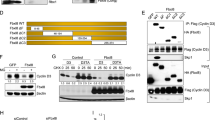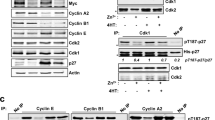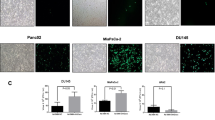Abstract
We have previously reported the identification of a novel 17 kDa truncated isoform of the cyclin D2 activated in 13% of the leukemias induced by the Graffi murine leukemia retrovirus. Retroviral integration in the Gris1 locus causes an alternative splicing of the mouse cyclin D2 gene and expression of a truncated protein of 159 amino acids that is detected at high levels in the Gris1 tumors and also in normal mouse tissues mainly the brain and ovaries. A truncated form of the cyclin D2 was also found in human. We show here that both mouse- and human-truncated cyclin D2 are able to transform primary mouse embryo fibroblasts (MEF) when co-expressed with an activated Ras protein. The truncated cyclin D2 localizes only to the cytoplasm of transfected cells. It has retained the ability to interact with cyclin-dependent kinases (CDKs), although it is a poor catalyst of pRb phosphorylation. Interestingly, the presence of a similar, alternatively spliced cyclin D2 mRNA was also detected in some human brain tumors.
This is a preview of subscription content, access via your institution
Access options
Subscribe to this journal
Receive 50 print issues and online access
$259.00 per year
only $5.18 per issue
Buy this article
- Purchase on Springer Link
- Instant access to full article PDF
Prices may be subject to local taxes which are calculated during checkout





Similar content being viewed by others
References
Andersen G, Busso D, Poterszman A, Hwang JR, Wurtz JM, Ripp R et al. (1997). The structure of cyclin H: common mode of kinase activation and specific features. EMBO J 16: 958–967.
Ando K, Ajchenbaum-Cymbalista F, Griffin JD . (1993). Regulation of G1/S transition by cyclins D2 and D3 in hematopoietic cells. Proc Natl Acad Sci USA 90: 9571–9575.
Assoian RK . (1997). Control of the G1 phase cyclin-dependent kinases by mitogenic growth factors and the extracellular matrix. Cytokine Growth Factor Rev 8: 165–170.
Baldin V, Lukas J, Marcote MJ, Pagano M, Draetta G . (1993). Cyclin D1 is a nuclear protein required for cell cycle progression in G1. Genes Dev 7: 812–821.
Bartkova J, Rajpert-de Meyts E, Skakkebaek NE, Bartek J . (1999). D-type cyclins in adult human testis and testicular cancer: relation to cell type, proliferation, differentiation, and malignancy. J Pathol 187: 573–581.
Buschges R, Weber RG, Actor B, Lichter P, Collins VP, Reifenberger G . (1999). Amplification and expression of cyclin D genes (CCND1, CCND2 and CCND3) in human maligant gliomas. Brain Pathol 9: 435–442.
Denicourt C, Kozak C, Rassart E . (2002). A new common integration site in Graffi MuLV-induced leukemias, Gris1: overexpression of a truncated cyclin D2 due to alternative splicing. J Virol 77: 37–44.
Diehl JA, Sherr CJ . (1997). A dominant-negative cyclin D1 mutant prevents nuclear import of cyclin-dependent kinase 4 (CDK4) and its phosphorylation by CDK-activating kinase. Mol Cell Biol 17: 7362–7374.
Diehl JA, Cheng M, Roussel MF, Sherr CJ . (1998). Glycogen synthase kinase-3beta regulates cyclin D1 proteolysis and subcellular localization. Genes Dev 12: 3499–3511.
Fisher CL, Pei GK . (1997). Modification of a PCR-Based site-directed mutagenesis method. Biotechniques 23: 570–574.
Greenberger JS, Sakakeeny MA, Humphries RK, Eaves CJ, Eckner RJ . (1983). Demonstration of permanent factor-dependent multipotential (erythroid/neutrophil/basophil) hematopoietic progenitor cell lines. Proc Natl Acad Sci USA 80: 2931–2935.
Hanna Z, Jankowski M, Tremblay P, Jiang X, Milatovich A, Francke U et al. (1993). The Vin-1 gene, identified by provirus insertional mutagenesis, is the cyclin D2. Oncogene 8: 1661–1666.
Jeffrey PD, Russo AA, Polyak K, Gibbs E, Hurwitz J, Massague J et al. (1995). Mechanism of CDK activation revealed by the structure of a cyclinA-CDK2 complex. Nature 376: 313–320.
Kato J, Matsuoka M, Polyak K, Massagué J, Sherr CJ . (1994). Cyclic AMP-induced G1 phase arrest mediated by an inhibitor (p27kip1) of cyclin-dependent kinase-4 activation. Cell 79: 487–496.
Kerkhoff E, Ziff EB . (1995). Cyclin D2 and Ha-Ras transformed rat embryo fibroblasts exhibit a novel deregulation of cell size control and early S phase arrest in low serum. EMBO J 14: 1892–1903.
Kim KK, Chamberlin HM, Morgan DO, Kim SH . (1996). Three-dimensional structure of human cyclin H, a positive regulator of the CDK-activating kinase. Nat Struct Biol 3: 849–855.
Lu F, Gladden AB, Diehl JA . (2003). An alternatively spliced Cyclin D1 isoform, Cyclin D1b, is a nuclear oncogene. Cancer Res 63: 7056–7061.
Malumbres M, Barbacid M . (2001). To cycle or not to cycle: a critical decision in cancer. Nat Rev Cancer 1: 222–231.
Matsuoka M, Kato JY, Fisher RP, Morgan DO, Sherr CJ . (1994). Activation of cyclin-dependent kinase 4 (cdk4) by mouse MO15-associated kinase. Mol Cell Biol 14: 7265–7275.
Matsushime H, Ewen ME, Strom DK, Kato JY, Hanks SK, Roussel MF et al. (1992). Identification and properties of an atypical catalytic subunit (p34PSK-J3/cdk4) for mammalian D type G1 cyclins. Cell 71: 323–334.
Ortega S, Malumbres M, Barbacid M . (2002). Cyclin D-dependent kinases, INK4 inhibitors and cancer. Biochim Biophys Acta 1602: 73–87.
Quelle DE, Ashmun RA, Shurtleff SA, Kato JY, Bar-Sagi D, Roussel MF et al. (1993). Overexpression of mouse D-type cyclins accelerates G1 phase in rodent fibroblasts. Genes Dev 7: 1559–1571.
Resnitzky D . (1997). Ectopic expression of cyclin D1 but not cyclin E induces anchorage-independent cell cycle progression. Mol Cell Biol 17: 5640–5647.
Roovers K, Davey G, Zhu X, Bottazzi ME, Assoian RK . (1999). Alpha5beta1 integrin controls cyclin D1 expression by sustaining mitogen-activated protein kinase activity in growth factor-treated cells. Mol Biol Cell 10: 3197–3204.
Russo AA, Jeffrey PD, Pavletich NP . (1996). Structural basis of cyclin-dependent kinase activation by phosphorylation. Nat Struct Biol 3: 696–700.
Schulze A, Zerfass-Thome K, Berges J, Middendorp S, Jansen-Durr P, Henglein B . (1996). Anchorage-dependent transcription of the cyclin A gene. Mol Cell Biol 16: 4632–4638.
Schwartz MA, Assoian RK . (2001). Integrins and cell proliferation: regulation of cyclin-dependent kinases via cytoplasmic signaling pathways. J Cell Sci 114: 2553–2560.
Sherr CJ, Roberts JM . (1999). CDK inhibitors: positive and negative regulators of G1-phase progression. Genes Dev 13: 1501–1512.
Sicinski P, Donaher JL, Geng Y, Parker SB, Gardner H, Park MY et al. (1996). Cyclin D2 is an FSH-responsive gene involved in gonadal cell proliferation and oncogenesis. Nature 384: 470–474.
Solomon DA, Wang Y, Fox SR, Lambeck TC, Giesting S, Lan Z et al. (2003). Cyclin D1 splice variants. Differential effects on localization, RB phosphorylation, and cellular transformation. J Biol Chem 278: 30339–30347.
Susaki E, Nakayama K, Nakayama KI . (2007). Cyclin D2 translocate p27 out of the nucleus and promotes its degradation at the G0–G1 transition. Mol Cell Biol 13: 4626–4640.
Tabin CJ, Bradley SM, Bargmann CI, Weinberg RA, Papageorge AG, Scolnick EM et al. (1982). Mechanism of activation of a human oncogene. Nature 300: 143–149.
Taïeb F, Jessus C . (1996). Xenopus cyclin D2: cloning and expression in oocytes and during early development. Biol Cell 3: 99–111.
Teramoto N, Pokrovskaja K, Szekely L, Polack A, Yoshino T, Akagi T et al. (1999). Expression of cyclin D2 and D3 in lymphoid lesions. Int J Cancer 81: 543–550.
Tremblay PJ, Kozak CA, Jolicoeur P . (1992). Identification of a novel gene, Vin-1, in murine leukemia virus-induced T-cell leukemias by provirus insertional mutagenesis. J Virol 66: 1344–1353.
Watanabe K, Tachibana O, Sata K . (1996). Overexpression of the EGF receptor and p53 mutations are mutually exclusive in the evolution of primary and secondary glioblastomas. Brain Pathol 6: 217–223.
Xiong Y, Zhang H, Beach D . (1992). D type cyclins associate with multiple protein kinases and the DNA replication and repair factor PCNA. Cell 71: 505–514.
Zhu X, Ohtsubo M, Bohmer RM, Roberts JM, Assoian RK . (1996). Adhesion-dependent cell cycle progression linked to the expression of cyclin D1, activation of cyclin E-cdk2, and phosphorylation of the retinoblastoma protein. J Cell Biol 133: 391–403.
Acknowledgements
We thank the Arthur and Sonia Labatt Brain Tumour Research Center (http://www.sickkids.ca/BTRC/ Toronto, Canada) and Dr Abhijit Guha for the gift of human tumor tissues. This work was supported by grant FRN 37994 from the Canadian Institutes of Health Research and by La Société de recherche sur le Cancer. CD is a recipient of a FCAR PhD scholarship.
Author information
Authors and Affiliations
Corresponding author
Additional information
Supplementary Information accompanies the paper on the Oncogene website (http://www.nature.com/onc).
Supplementary information
Rights and permissions
About this article
Cite this article
Denicourt, C., Legault, P., McNabb, FA. et al. Human and mouse cyclin D2 splice variants: transforming activity and subcellular localization. Oncogene 27, 1253–1262 (2008). https://doi.org/10.1038/sj.onc.1210750
Received:
Revised:
Accepted:
Published:
Issue Date:
DOI: https://doi.org/10.1038/sj.onc.1210750
Keywords
This article is cited by
-
Gene identification and functional analysis of a D-type cyclin (CCND2) in freshwater pearl mussel (Hyriopsis cumingii)
Molecular Biology Reports (2022)
-
Identification of GPM6A and GPM6B as potential new human lymphoid leukemia-associated oncogenes
Cellular Oncology (2014)



